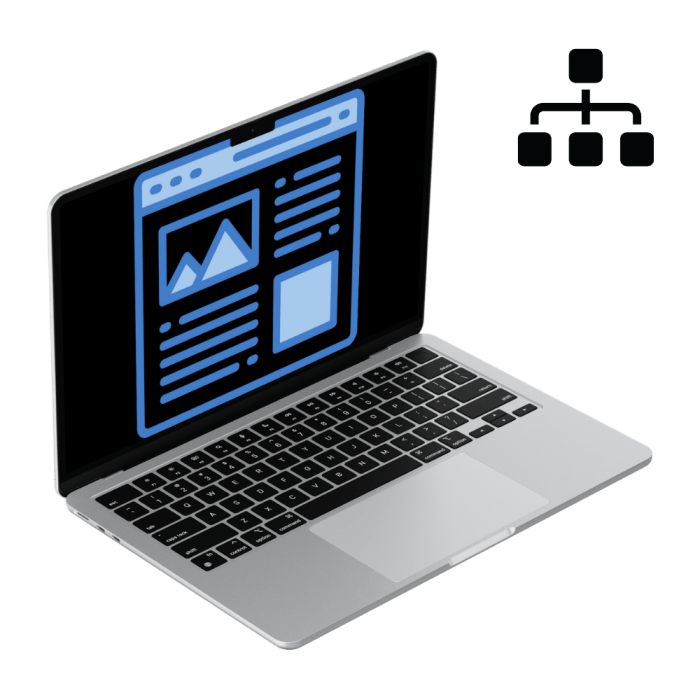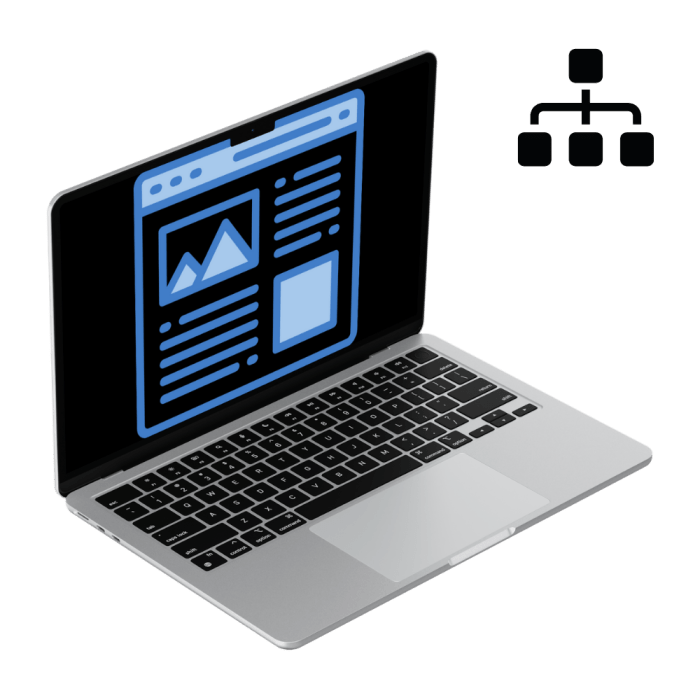What is content mapping and why is it significant to websites? This exploration delves into the crucial role content mapping plays in website success. A well-structured content map isn’t just a pretty diagram; it’s a roadmap to organizing content effectively, optimizing user experience, and ultimately boosting website performance. From understanding target audiences to streamlining content creation, this guide unpacks the methodology and benefits of content mapping.
Content mapping goes beyond simply listing pages. It’s about aligning your website’s content with user needs, creating a seamless and engaging experience. By understanding your target audience and mapping their journey, you can strategically place content to address their pain points and desires, ultimately increasing engagement and conversions.
Defining Content Mapping
Content mapping is a strategic process of organizing and planning website content to align with business objectives. It’s more than just creating a list of pages; it’s a blueprint for how your content will serve your users and drive desired actions. This structured approach ensures every piece of content contributes to the overall success of the website.Content mapping helps you understand your audience’s needs and how your content can fulfill them.
It’s a proactive way to ensure your website is effectively communicating with its intended visitors, leading to higher engagement and conversions.
Core Principles of Content Mapping
Content mapping is built on several key principles. These ensure the content is not only relevant but also easily discoverable and valuable to the target audience. A well-defined content map prioritizes user needs, aligns with business goals, and creates a seamless user experience.
Key Components of a Robust Content Mapping Strategy
A robust content mapping strategy encompasses several crucial elements. These elements work together to create a comprehensive framework for planning, organizing, and delivering valuable content.
- Understanding the Target Audience: Thorough market research and user persona development are essential. Understanding the demographics, needs, and pain points of your target audience allows you to tailor content to their specific interests and concerns. This step is critical for creating relevant and engaging content that resonates with the target audience.
- Defining Business Objectives: A clear understanding of the website’s goals is fundamental. This could include driving sales, increasing brand awareness, or generating leads. The content map should directly support these objectives, guiding the creation of content that directly addresses the needs of the business.
- Identifying Content Gaps: Analyze existing content and identify areas where gaps exist. This analysis should uncover what topics are missing or need improvement, ensuring a complete and comprehensive information architecture.
- Creating a Content Inventory: Document all existing content assets, including blog posts, landing pages, and product descriptions. This step helps to avoid duplication of effort and ensures that all content is accounted for and considered during the mapping process.
- Developing a Content Strategy: Once the audience, objectives, and gaps are understood, create a detailed strategy that aligns the content with the overall marketing plan. This is a crucial step to ensure that the content is aligned with the overall business strategy and effectively achieves the set objectives.
Example Content Map Structure
A well-structured content map is organized and easily understood. The following table provides a basic visual representation of a content map structure with three key columns:
| Topic | Target Audience | Key Message |
|---|---|---|
| Gardening Tools for Beginners | Homeowners with limited gardening experience | Learn the basics of gardening and discover the best tools to get started. |
| Advanced Gardening Tools | Experienced gardeners seeking high-performance tools | Enhance your gardening expertise with premium tools for optimal results. |
| Seasonal Gardening Tools | Gardeners needing specialized tools for specific seasons | Find the right tools for each season to maximize your garden’s potential. |
Example Content Map: Gardening Tools Website
Let’s consider a hypothetical website selling gardening tools. The following content map section illustrates how a content map can be applied to a specific business context:
| Topic | Target Audience | Key Message |
|---|---|---|
| Hand Tools | Home gardeners, DIY enthusiasts | Efficient and reliable hand tools for everyday gardening tasks. |
| Power Tools | Commercial gardeners, landscapers | Powerful and durable power tools for large-scale gardening projects. |
| Seasonal Tool Kits | Home gardeners preparing for spring or fall | Comprehensive kits tailored for specific seasons to simplify gardening tasks. |
Benefits of Content Mapping for Websites: What Is Content Mapping And Why Is It Significant To Websites
Content mapping isn’t just a fancy organizational tool; it’s a cornerstone for building effective and user-friendly websites. By strategically planning the content, you can create a cohesive experience that not only satisfies visitors but also drives key performance indicators like engagement and conversions. A well-structured website, based on a solid content map, facilitates a seamless user journey, making it easier for visitors to find the information they need.A well-executed content map acts as a blueprint, guiding the creation and management of website content.
It ensures all content contributes to the overall website goals, rather than being scattered and unfocused. This structured approach, which is a key component of modern web design, is crucial for maintaining a consistent brand message and user experience across the site.
Improved Website Organization
Content mapping creates a clear hierarchy and structure for your website’s content. This logical organization streamlines navigation, allowing users to easily find the information they seek. It reduces the feeling of being lost or overwhelmed, a key factor in user retention. Well-defined categories and subcategories within the map ensure that every page has a clear purpose and place within the overall website architecture.
This structured approach minimizes redundancy and ensures a seamless user experience.
Streamlined Content Creation and Management
Content mapping serves as a central repository for all content ideas and strategies. This unified approach allows teams to collaborate effectively, reducing conflicts and ensuring consistency in messaging and branding. It helps prioritize content creation efforts, focusing resources on the most important and impactful topics. This central planning ensures that content is created with a clear understanding of its role in the overall website strategy.
Impact on User Experience
A well-mapped website offers a superior user experience. The logical flow of content and clear navigation enhance user satisfaction and reduce bounce rates. Users are more likely to stay engaged when they can easily find the information they need. A well-organized website fosters a sense of trust and professionalism, crucial for building a strong online presence. The seamless navigation, coupled with well-structured content, reduces user frustration and increases overall satisfaction.
Increased Website Traffic
Content mapping facilitates the development of a comprehensive content strategy. By identifying target audiences and their specific information needs, you can create content that resonates with them, driving more organic traffic to your site. A well-defined content map allows for strategic placement, optimizing for search engines and attracting relevant traffic. Well-mapped websites with appropriate placement will increase organic traffic by attracting relevant visitors, leading to a stronger online presence.
Content Mapping and
Content mapping directly impacts efforts. By understanding the relationships between different pieces of content, you can optimize your site for relevant s, improving search engine rankings. This strategic integration ensures that search engines can easily understand the purpose of your pages and rank them accordingly. This optimized structure will improve search engine rankings, increasing visibility and attracting targeted traffic.
Examples of Well-Mapped vs. Poorly-Mapped Websites
Imagine a clothing retailer. A well-mapped website would clearly categorize products (e.g., men’s shirts, women’s dresses, accessories) and offer detailed product pages with high-quality images and descriptions. Conversely, a poorly mapped site might scatter similar items across different pages, making it difficult for users to find what they need. This leads to a poor user experience, impacting sales.Another example: a blog about cooking.
A well-mapped blog would have categories like “breakfast recipes,” “dinner recipes,” “vegan recipes,” and subcategories for specific cuisines. This clear structure allows users to easily find the content they’re looking for. A poorly mapped blog, on the other hand, might have all recipes jumbled together, making it difficult to navigate and find specific recipes. This disorganized structure hurts user engagement and the blog’s reputation.
Comparison Table
| With Content Mapping | Without Content Mapping |
|---|---|
| Clear website structure, logical navigation | Scattered content, confusing navigation |
| Improved user experience, reduced bounce rate | Poor user experience, high bounce rate |
| Targeted content creation, optimized for | Unfocused content creation, poor performance |
| Increased website traffic, higher conversion rates | Limited website traffic, lower conversion rates |
| Enhanced brand consistency, better brand perception | Inconsistent messaging, weakened brand perception |
Content Mapping Processes and Methods
Content mapping isn’t just about creating a list of pages. It’s a strategic process that meticulously plans how your website’s content supports your overall business goals. Understanding the methods and processes involved is crucial for effective content creation and optimization. This section delves into the practical steps of building a robust content map, ensuring it aligns perfectly with your target audience and business objectives.Effective content mapping requires a deep understanding of your target audience and their needs.
Content mapping’s all about strategically organizing your website content to guide visitors. It’s crucial for a website’s success because it helps ensure your content is relevant and accessible. Understanding your target audience and aligning your content accordingly is key, which often means implementing growth hacks increase online sales, like these ones. Ultimately, good content mapping makes your site user-friendly and boosts search engine rankings, making it a powerful tool for any online presence.
This is achieved through various methods, including user research and persona development. Understanding the ‘why’ behind user interactions with your website is essential for creating valuable and relevant content.
Content Mapping Methodologies
Understanding your target audience is fundamental to content mapping. Different methodologies help uncover user needs and behaviors. User journey mapping traces the steps a user takes to achieve a goal on your site. This visualization allows you to pinpoint potential friction points and opportunities for improvement. Persona development creates detailed representations of your ideal customers, including their demographics, motivations, and pain points.
These insights inform content creation by ensuring it resonates with the specific needs of each segment of your target audience.
Content mapping is all about strategically organizing your website’s content to guide users and search engines. It’s crucial for a website’s success, ensuring that information is easily accessible and relevant. Understanding how your content aligns with your overall marketing goals, like figuring out if product marketing or general marketing strategies are better for driving sales, as detailed in this insightful article ( product marketing vs marketing which strategy drives sales ), is key.
Ultimately, well-structured content mapping improves user experience and search engine optimization, boosting your website’s visibility and effectiveness.
Steps in Creating a Content Map
Creating a content map involves several key steps. These steps ensure that your content strategy aligns with your overall business goals and effectively serves your target audience. A clear understanding of these steps is essential for a successful content mapping project.
Content Audit
A content audit is a critical step in content mapping. It’s a comprehensive evaluation of your existing content. This involves analyzing existing content, identifying gaps, and assessing its relevance to your target audience. This meticulous review allows you to understand what’s working and what needs improvement. The audit provides valuable insights into areas for content optimization.
Thorough content audits are essential for creating a content strategy that leverages existing assets effectively.
Examples of Content Mapping Tools
Several tools can streamline the content mapping process. These tools offer features to manage content, track performance, and analyze user behavior. Tools like Airtable, Google Sheets, and specialized content management systems (CMS) often offer features that help with content organization and tracking. The selection of tools depends on your specific needs and budget.
Content Mapping Project Guide
| Step | Description | Example |
|---|---|---|
| 1. Define Project Goals | Clearly articulate the objectives of the content mapping project. What do you hope to achieve? Examples: Increased lead generation, improved user engagement, enhanced brand awareness. | Increase website traffic by 20% within the next quarter. |
| 2. Conduct User Research | Identify your target audience and their needs. Use methods like surveys, interviews, and user testing to understand their behaviors and preferences. | Conduct 10 user interviews to gather insights on user experience. |
| 3. Create User Personas | Develop detailed representations of your ideal customers, including their demographics, motivations, and pain points. | Create a persona profile for a “first-time homebuyer” with details on their interests and concerns. |
| 4. Perform Content Audit | Analyze existing website content to identify gaps, strengths, and weaknesses. Evaluate content’s relevance, quality, and accessibility. | Review existing blog posts for usage, relevance, and overall quality. |
| 5. Create Content Map | Organize content into a hierarchical structure that aligns with user needs and business objectives. | Structure blog posts under categories like “Buying Guide,” “Home Improvement,” and “Financing.” |
| 6. Prioritize Content | Determine which content pieces need updating, creation, or removal. | Prioritize blog posts based on engagement metrics and relevance to user needs. |
| 7. Implement Content Plan | Develop a plan for creating, updating, and promoting content. | Schedule blog posts, optimize for search engines, and promote content on social media. |
| 8. Track and Measure Results | Monitor content performance and make adjustments as needed. Use analytics to track key metrics like traffic, engagement, and conversions. | Track website traffic and engagement metrics to assess the effectiveness of the content mapping project. |
Content Mapping and User Needs

Understanding your target audience is paramount to creating a successful website. A well-defined content map, meticulously crafted with user needs in mind, ensures that your site not only looks good but also effectively serves its intended purpose. This goes beyond simply listing topics; it’s about understanding how users interact with your brand and how your content fulfills their needs.Content mapping, in essence, is a strategic framework that bridges the gap between user expectations and your website’s offerings.
It translates user needs into actionable content strategies, allowing your website to cater to specific user personas and drive desired outcomes. By aligning your content with user expectations, you create a more engaging and valuable experience.
Importance of Understanding Target Audiences
Content mapping hinges on a deep understanding of your target audience. This involves researching their demographics, motivations, pain points, and online behavior. Knowing your users allows you to create content that resonates with them, addressing their specific needs and desires. Without this understanding, your content may fall flat, failing to connect with the intended audience and ultimately hindering your website’s effectiveness.
Addressing User Needs and Expectations, What is content mapping and why is it significant to websites
Content mapping directly addresses user needs and expectations by meticulously planning the content to meet those needs. This involves identifying the information users seek, the problems they need solved, and the experiences they desire. By mapping these needs to specific content pieces, the website becomes a valuable resource tailored to its target audience.
Methods for Researching Target Audience Needs
Several methods can be employed to effectively research target audience needs. These include surveys, interviews, focus groups, and analyzing user behavior on similar websites. By gathering qualitative and quantitative data, you gain valuable insights into user motivations, pain points, and information-seeking patterns. This data fuels the development of a content map that is truly user-centric.
- Surveys: Surveys are a quantitative method for gathering data on user preferences, pain points, and content consumption habits. They allow for a broad understanding of user needs across a wider sample size.
- Interviews: In-depth interviews provide qualitative data on user motivations, behaviors, and experiences. They offer valuable insights into user needs and perspectives that may not be evident through survey data.
- Focus Groups: Focus groups provide a platform for group discussions on specific topics. They offer a dynamic setting to gather diverse opinions and insights into user needs.
- Analyzing User Behavior: Examining user behavior on similar websites, including their browsing patterns and engagement metrics, provides valuable insights into user needs and content consumption patterns.
Creating a Tailored User Experience
By carefully mapping content to specific user needs, you craft a tailored experience for users. This involves creating content that directly addresses their questions, concerns, and desires. A tailored user experience fosters engagement, encourages interaction, and ultimately enhances the value proposition of your website. Content tailored to specific needs fosters trust and satisfaction, encouraging repeat visits.
A well-structured content map ensures that users find the information they need quickly and easily. This contributes to a positive user experience and promotes engagement.
User Persona for a Hypothetical Website
Name: Eco-Conscious Emily Age: 30 Occupation: Environmental Consultant Interests: Sustainable living, eco-friendly products, reducing carbon footprint, and gardening. Goals: Find resources for eco-friendly living, compare eco-friendly products, and learn how to minimize her environmental impact. Frustrations: Difficulty finding reliable information on eco-friendly products and lack of transparency in product certifications.
User Journey on a Hypothetical Website
| User Action | Page | Content | User Intent |
|---|---|---|---|
| Lands on homepage | Homepage | Overview of eco-friendly products, blog posts on sustainability, contact information | Explore the website and learn about sustainable living |
| Clicks on “Eco-Friendly Products” | Product Category Page | Detailed descriptions of various products, certifications, reviews | Compare products and find suitable options |
| Selects a specific product | Product Detail Page | Detailed information about the product, specifications, pricing, reviews | Confirm product suitability and purchase |
| Adds to cart | Shopping Cart Page | Summary of selected products, checkout options | Proceed with purchase |
Content Mapping and Content Strategy
Content mapping isn’t just about organizing website content; it’s a powerful tool for aligning your content with your overall business strategy. A well-defined content strategy provides the roadmap for your content, and content mapping acts as the detailed blueprint, ensuring every piece of content serves a specific purpose and contributes to your overarching goals. This synergy is crucial for achieving optimal results.Content mapping provides a structured approach to content creation, ensuring that your efforts are focused and aligned with your business objectives.
By clearly defining the intended audience, purpose, and value proposition of each piece of content, you can create more effective and engaging materials. This approach fosters a consistent brand voice and messaging across all platforms.
Relationship Between Content Mapping and Content Strategy
Content mapping serves as a critical component within a broader content strategy. A content strategy Artikels the overall direction and goals for your content, while content mapping provides the detailed plan for achieving those goals. Think of it like this: the content strategy is the overarching vision, and the content map is the tactical plan to realize that vision.
Content mapping is all about strategically planning the content on your website to guide users and boost SEO. It’s crucial for creating a user-friendly experience and helps search engines understand your site’s structure. For example, optimizing your pest control images for visual appeal, using relevant keywords, and ensuring clear calls to action is important for improving engagement and driving conversions.
Check out these 12 tips to optimize your pest control images for better web design, social media, and SEO here. Ultimately, good content mapping ensures your website is well-organized and provides a seamless user journey, making it easier for both visitors and search engines to find the information they need.
The content map translates the strategy into actionable steps for content creation, optimization, and performance tracking.
How Content Mapping Informs Content Creation
Content mapping guides content creation by providing a clear framework for understanding the needs of your target audience and the value your content offers. Each piece of content is mapped to a specific user persona, need, and stage in the buyer’s journey. This ensures that content is tailored to resonate with the intended audience and effectively addresses their specific questions and concerns.
This tailored approach fosters a better user experience and increases engagement.
Role of Content Mapping in Optimizing Content Performance
Content mapping is instrumental in optimizing content performance by aligning content with specific user needs and goals. By identifying the purpose and value of each piece of content, you can effectively measure its impact and make necessary adjustments to improve its performance. This allows for a data-driven approach to content optimization, ensuring that your efforts are focused on creating content that truly delivers value.
This data-driven approach is essential for maintaining and improving website performance.
Aligning Content Mapping with Marketing Goals
Effective content mapping must align with your overall marketing goals. This means that each piece of mapped content should directly contribute to achieving a specific marketing objective, such as lead generation, brand awareness, or sales conversion. The mapping process should incorporate key performance indicators (KPIs) that can be tracked to measure the success of each content piece in relation to the overall marketing strategy.
Content Strategy Document Incorporating Content Mapping Principles
| Goal | Content Type | Target Audience |
|---|---|---|
| Generate leads for new software | Case studies, webinars, blog posts | Potential clients interested in software solutions for business process automation. |
| Increase brand awareness | Social media posts, infographics, articles | General business professionals and industry leaders. |
| Drive sales conversions | Product demos, pricing pages, product sheets | Decision-makers and purchasing managers looking for specific product information. |
Connection Between Content Mapping and Website Analytics
Content mapping and website analytics are intrinsically linked. By analyzing website traffic, user behavior, and engagement metrics, you can gain valuable insights into how your content is performing and identify areas for improvement. This allows for iterative adjustments to your content strategy and mapping to better serve your audience. Analyzing analytics provides data-backed information about the success and impact of your content.
This information allows for the refinement and improvement of content strategy and mapping.
Content Mapping for Different Website Types
Content mapping isn’t a one-size-fits-all solution. Effective content strategies need to be tailored to the specific needs and goals of each website type. Understanding the distinct characteristics of e-commerce, blog, and informational websites, along with industry-specific nuances, is crucial for developing a successful content map. This tailoring extends to mobile-first design considerations, user behavior changes, and even seasonal or promotional content.Different website types require different approaches to content mapping, reflecting the varying user journeys and information needs.
This adaptation allows businesses to optimize their content for maximum impact, driving engagement and achieving specific objectives.
Content Mapping Strategies for E-commerce Websites
E-commerce websites prioritize driving conversions and sales. Content maps for these sites need to focus on user needs related to product discovery, comparison, and purchase. Detailed product descriptions, high-quality images, customer reviews, and clear calls-to-action are essential components. The content map should also incorporate strategies for guiding users through the checkout process. A clear, concise, and easily navigable site structure is crucial to facilitate the purchase process.
Specific content mapping strategies for e-commerce sites should also include product category pages, product detail pages, and search results pages.
Content Mapping Strategies for Blogs
Blogs, on the other hand, aim to engage readers and build a community. Content mapping for blogs should emphasize creating valuable, informative, and shareable content that resonates with the target audience. Content maps for blogs should include a calendar to plan and schedule content for optimal reach and engagement. Regularly updating the blog with new content is crucial to maintain reader interest.
The content should be optimized for search engines to attract new readers. Content mapping for blogs should also consider different content formats like articles, listicles, infographics, and videos.
Content Mapping Strategies for Informational Websites
Informational websites aim to provide comprehensive information on a specific topic or industry. Content mapping for these sites focuses on providing detailed, accurate, and up-to-date information. Content mapping for informational sites should also include clear navigation structures to help users find the information they need. These sites frequently require in-depth articles, guides, and tutorials to address the detailed needs of their users.
Content Mapping for Different Industries
Content mapping strategies can differ significantly depending on the industry. For example, a healthcare website will need content focused on patient education and medical information, whereas a technology website might focus on product reviews and technical specifications. A financial website will emphasize financial literacy and investment strategies. The industry’s specific needs, regulations, and target audience should be considered during the content mapping process.
The specific tone and style of content will vary greatly depending on the industry.
Content Mapping for Mobile-First Design
Mobile-first design is essential in today’s digital landscape. Content mapping should consider the specific needs of mobile users. This means designing content that is easily digestible and navigable on smaller screens. Content should be concise and prioritize key information. Content mapping for mobile should also consider the use of interactive elements and responsive design to improve user experience.
The content should be easily accessible on smaller screens.
Content Mapping for Seasonal or Promotional Content
Content mapping should be flexible enough to accommodate seasonal or promotional content. Content maps can be updated to include relevant content that aligns with current events or trends. Seasonal promotions, holidays, or special events can be reflected in the content map to capitalize on increased user interest. For example, an e-commerce website might map out special offers for the holiday season, while a travel blog might feature destinations that are popular during the summer months.
These additions can be included in the existing content map or as new segments.
| Website Type | Content Map Strategy |
|---|---|
| E-commerce | Focus on product discovery, comparison, and purchase. Include detailed product descriptions, high-quality images, customer reviews, and clear calls-to-action. |
| Blog | Emphasize creating valuable, informative, and shareable content that resonates with the target audience. Optimize content for search engines. |
| Informational | Prioritize providing detailed, accurate, and up-to-date information on a specific topic. Create clear navigation structures. |
Ending Remarks

In conclusion, content mapping is not just a technical exercise but a strategic imperative for any website. By understanding your target audience, organizing your content effectively, and aligning your strategy with your marketing goals, you can create a website that not only looks good but also performs exceptionally well. This detailed approach to content organization empowers you to create a user-centric website that is both engaging and effective, ultimately driving business success.









